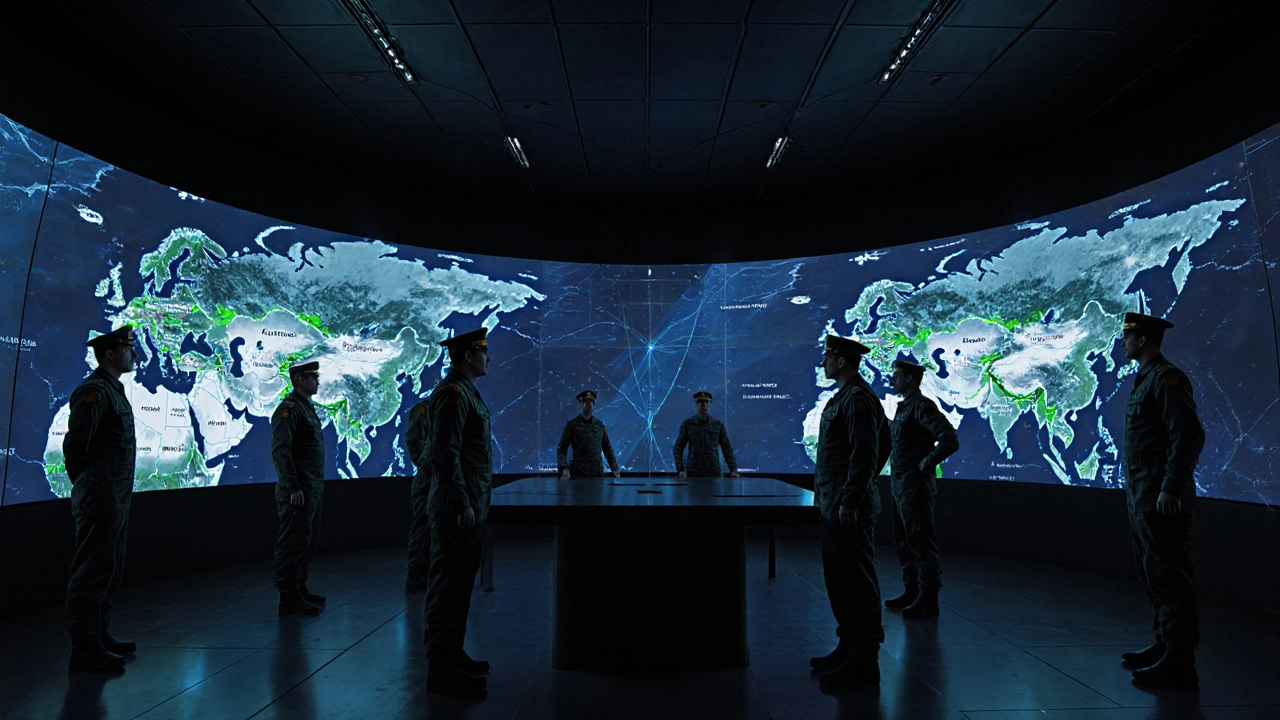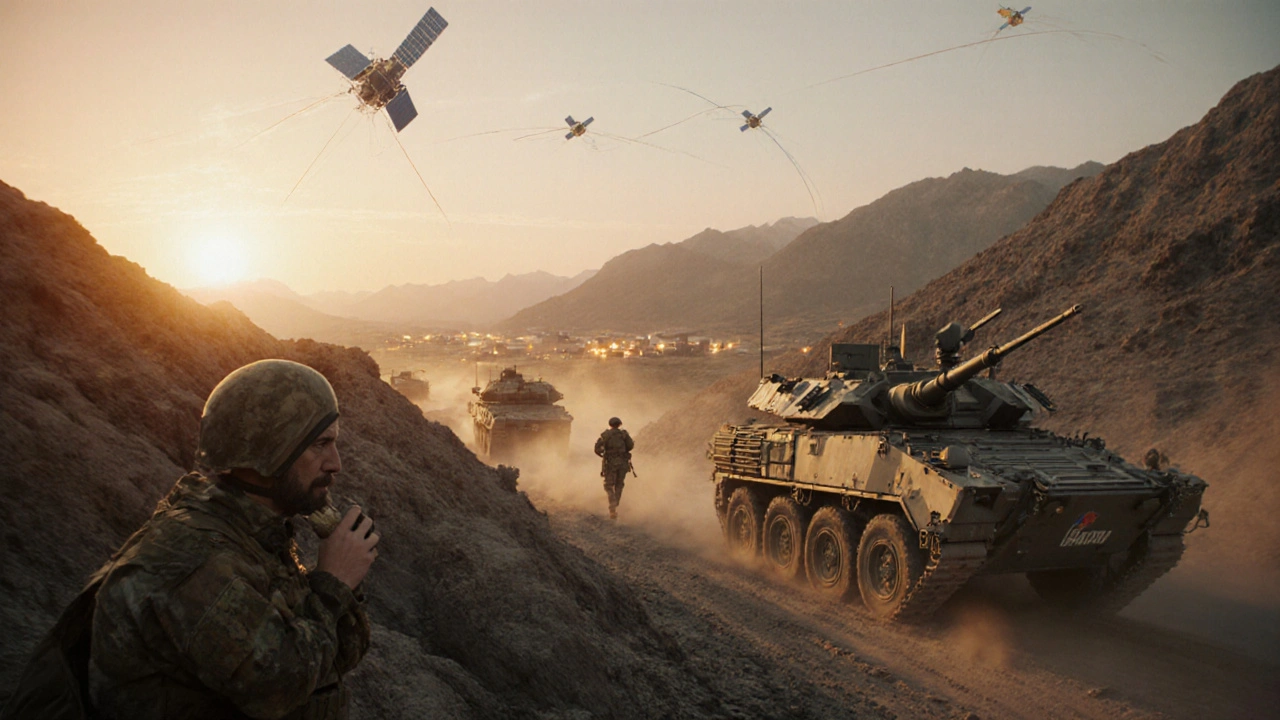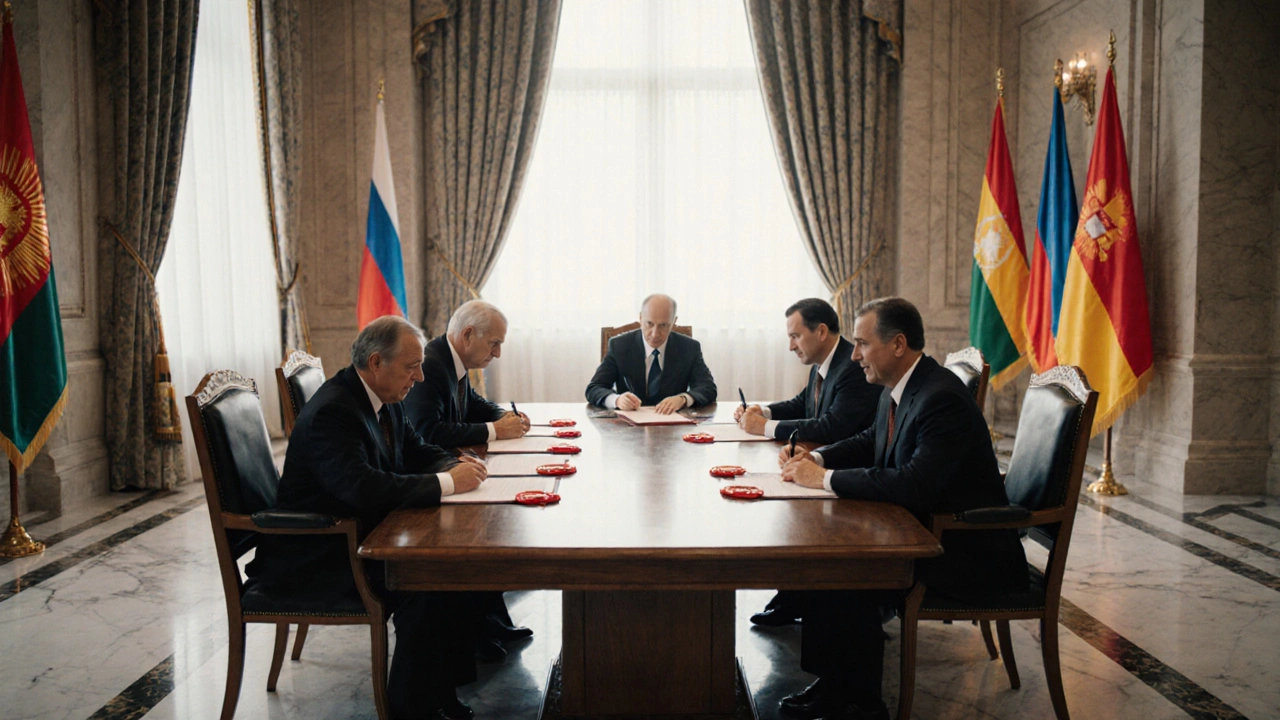CSTO vs NATO Comparison Tool
NATO
CSTO
Core Defense Clause
Article 5: Attack on one is attack on all
Collective defense clause: Limited to treaty area
Space Assets
GPS, NATO-wide satellite communications
GLONASS access, Russian military satellites
Decision-Making Process
NATO: Consensus (but can be overridden by unanimity)
CSTO: Unanimity required
This means Russia holds significant influence in the CSTO due to its size and budget contribution.
When you hear "NATO" you probably picture a 30‑nation military alliance stretching across North America and Europe. Russia, however, has its own version of that club - the Collective Security Treaty Organization (CSTO) is a post‑Soviet security pact that promises mutual defence among its members. In this guide we’ll break down what the CSTO is, how it works, and why it matters for anyone watching geopolitics or even space‑based security.
What is the CSTO?
The CSTO started as the “Collective Security Treaty” signed in 1992, after the Soviet Union fell apart. Its original goal was to keep the newly independent states safe from external threats and to coordinate their militaries. Today, the organization includes six members - Russia, Armenia, Belarus, Kazakhstan, Kyrgyz Kyrgyzstan, and Tajikistan - and its headquarters sit in Moscow.
How the CSTO Was Born
Right after the USSR’s collapse, former republics faced a security vacuum. Leaders gathered in Moscow in May1992 and signed a treaty that created a collective defence system similar to NATO’s Article 5. The treaty officially entered force in March1994. Over the years, the CSTO added more members and signed several protocols that expanded its scope to include joint training, intelligence sharing, and even disaster relief.
Members, Structure, and Decision‑Making
Each member nation appoints a representative to the CSTO’s Council, the top decision‑making body. The Council meets at least once a year, and decisions require unanimity - a rule that gives Russia a huge sway, simply because it’s the biggest contributor in troops and budget.
- Russia: Provides the bulk of the budget (about 70%) and most of the forces.
- Armenia: Hosts the CSTO peace‑keeping headquarters in Yerevan.
- Belarus: Offers strategic air bases near NATO’s eastern flank.
- Kazakhstan: Contributes ground forces and a network of surveillance satellites.
- Kyrgyzstan and Tajikistan: Provide border‑security troops that patrol the volatile Afghan frontier.
Below the Council sits the Joint Staff, a permanent body that drafts military plans and coordinates exercises. The CSTO also runs a joint command centre in Moscow where Russia’s armed forces can directly issue orders to allied troops during a crisis.

CSTO vs. NATO: A Quick Comparison
| Aspect | NATO | CSTO |
|---|---|---|
| Founding Year | 1949 | 1992 (treaty 1994) |
| Member Count | 31 | 6 |
| Defense Spending (2023) | $1.1trillion | ≈$30billion (mostly Russian budget) |
| Decision Rule | Consensus (but can be overridden by unanimity) | Unanimity required |
| Core Clause | Article5 - attack on one is attack on all | Collective defence clause - similar but limited to treaty area |
| Joint Exercises | Annual "Trident Juncture" and many regional drills | "Diamonds Future" and "CSTO‑RUS" exercises |
| Space Assets | GPS, NATO‑wide satellite communications | GLONASS access, Russian military satellites shared with members |
Why Space Matters to the CSTO
Although the CSTO is primarily a land‑based security pact, modern warfare leans heavily on space. Russia’s GLONASS is a global navigation satellite system that provides positioning data to all CSTO forces, essentially giving them a GPS‑like capability that NATO members can’t rely on without permission.
In addition to GLONASS, Russia operates several military observation satellites - the “Kosmos” series - that monitor borders and missile launches. During the 2022 Kyrgyzstan unrest, CSTO troops used real‑time satellite imagery to plan troop movements across rugged terrain, shortening response time by a day.
These space resources also feed into joint command centres, where data from ground radars and air patrols are fused with satellite feeds. That integration allows CSTO commanders to see a full picture of a crisis zone, a capability NATO has but with different satellite providers.
Real‑World Operations: From Peace‑Keeping to Border Patrol
The CSTO has been invoked a few times since its inception. Here are the most notable missions:
- 1999 Tajikistan Civil War - CSTO sent a limited contingent of Russian troops to stabilize the capital Dushanbe.
- 2020 Kyrgyzstan Protests - A rapid‑deployment force entered the country after the government requested help, securing the parliament building and restoring order within 48hours.
- 2022 Kazakhstan Unrest - Around 3,000 CSTO troops, mainly Russian, helped the Kazakh government regain control of key oil facilities.
- Border security in the Afghan‑Tajik gap - Joint patrols use satellite‑linked communication to monitor illegal crossings and drug trafficking.
Unlike NATO, which often conducts large‑scale multinational operations far from member borders, the CSTO’s actions stay close to home, reflecting the regional focus of its treaty.

Criticisms and Limitations
Analysts point out several weaknesses:
- Over‑reliance on Russia: With Russia covering most of the budget, the alliance can’t act independently if Moscow’s interests shift.
- Limited strategic depth: Only six members mean the CSTO can’t project power like NATO does.
- Political frictions: Armenia’s conflict with Azerbaijan sometimes pits CSTO members against each other, complicating collective decisions.
- Technology gap: While sharing GLONASS helps, CSTO forces still lag behind NATO in terms of advanced stealth aircraft and cyber‑defence tools.
These shortcomings explain why the CSTO is often described as “NATO‑lite” rather than a true counterpart.
Future Outlook: Will the CSTO Grow?
There are rumours that countries like Uzbekistan or even Iran might seek observer status. Yet, expanding the pact would require unanimous approval, and existing members are cautious about diluting Russian influence.
What’s clearer is the growing importance of space assets. As Russia upgrades its satellite constellations, CSTO members will likely get more integrated access, making the alliance more relevant for cyber‑defence and missile‑early‑warning tasks.
For now, the CSTO remains a regional security club with a heavy Russian imprint - the closest thing the Kremlin has to NATO.
Frequently Asked Questions
What does CSTO stand for?
CSTO stands for the Collective Security Treaty Organization, a military alliance of six post‑Soviet states.
Is the CSTO a direct copy of NATO?
Not exactly. While both promise mutual defence, NATO has 31 members, a larger budget, and a global reach. The CSTO is smaller, focuses on Central Asia, and depends heavily on Russia.
Which satellites does the CSTO use?
Member states mainly rely on Russia’s GLONASS for navigation and on the Kosmos series of military observation satellites for reconnaissance.
Has the CSTO ever intervened militarily?
Yes. Notable interventions include the 2020 Kyrgyzstan protests, the 2022 Kazakhstan unrest, and peace‑keeping missions in Tajikistan during the 1990s.
Can a CSTO member act without Russia’s consent?
In theory, decisions require unanimity, so any major action needs Russia’s agreement. Smaller joint exercises can be organized by individual members, but large deployments are coordinated through Moscow.


15 Responses
The CSTO essentially mirrors NATO’s mutual‑defence promise but keeps the spotlight on the post‑Soviet space, binding six nations under a single security umbrella.
Unanimity in the CSTU Council means every member, from Armenia to Kazakhstan, must sign off on a joint operation, which inevitably gives Russia a de‑facto veto and a steering wheel on strategic decisions.
This design was intended to prevent splintered actions, but it also locks the alliance into Moscow’s strategic calculus.
The treaty’s official designation is the Collective Security Treaty Organization, and despite occasional misprints, the current roster stays at six member states.
Each contributes troops, but Russia shoulders roughly 70 % of the budget, shaping the alliance’s operational tempo.
The CSTO’s existence feels like a lingering echo of Cold War camaraderie, a pact forged in the ashes of a dissolved empire. Its founding members hurriedly signed the treaty, hoping to plug the security vacuum that yawned across the former Soviet hinterland. Yet the very speed of that agreement sowed seeds of ambiguity that still sprout today. When the council meets, the air is thick with the weight of historic grievances, especially between Armenia and Azerbaijan. Russia, perched at the helm, watches each debate with the patience of a seasoned conductor, ready to cue the orchestra at a moment’s notice. Member states, though nominally equal, often find themselves dancing to Moscow’s melody, aligning their national drums to a single beat. The joint staff drafts plans that sound impressive on paper, but the rubber meets the road only when troops are ordered to cross borders. In Kazakhstan’s vast steppes, the CSTO’s presence is marked by satellite uplinks that blink like fireflies against the night. Kyrgyzstan’s mountainous terrain tests the alliance’s logistical dexterity, forcing innovative mountain‑warfare tactics. Meanwhile, Tajikistan’s porous frontier with Afghanistan remains a hot spot for insurgent spill‑over, reminding everyone why the treaty was never just a diplomatic nicety. The GLONASS constellation, though praised, still lags behind the precision of its Western counterparts, a gap that becomes glaring during fast‑moving crises. Observers often note that the CSTO’s exercises, dubbed “Diamonds Future,” showcase impressive coordination but hide underlying command frictions. Critics argue that without genuine multilateral investment, the alliance risks becoming a shadow of its NATO counterpart, merely a regional safety net. Nevertheless, the sheer fact that six nations can still muster a unified response in 2024 speaks to a shared sense of survival. In the end, whether the CSTO evolves or stalls will depend on the very balance of power it was designed to protect.
It's encouraging to see regional powers pooling resources for disaster relief and border security.
Russia’s financial muscle essentially ties the CSTO’s leash to Moscow, making any independent Balkan‑style initiative highly improbable.
That reality forces smaller allies to align their foreign policies with Russian interests.
The CSTO’s technology stack remains a patchwork of legacy Soviet hardware and token GLONASS integration, leaving member forces vulnerable to modern cyber‑espionage vectors.
Without substantial investment in stealth platforms or AI‑driven ISR, the alliance risks becoming a ceremonial coalition rather than a credible deterrent.
In the grand chessboard of Eurasia, the CSTO acts as a quiet guardian, its moves dictated less by ideology and more by the invisible pull of shared history.
The CSTO’s joint command centre in Moscow serves as a central hub where orders flow swiftly, though occasional bureaucratic hiccups can delay on‑ground execution.
Seeing GLONASS satellites light up the night sky over Central Asia feels like a reminder that space is the new frontier for old alliances 🌌🚀
Russia basically funds the whole thing.
Understanding the limits of the CSTO helps us appreciate why smaller states cling to any security guarantee they can get.
While most see the CSTO as Moscow’s puppet, it could also be viewed as a platform for its members to negotiate leverage with the West.
If you’re curious about how the CSTO drills actually run, check out the public videos from the “Diamonds Future” exercises-they show a lot of joint logistics in action.
The article overlooks the fact that CSTO’s decision‑making process, demanding unanimity, often stalls when geopolitical interests diverge, which is a critical flaw.